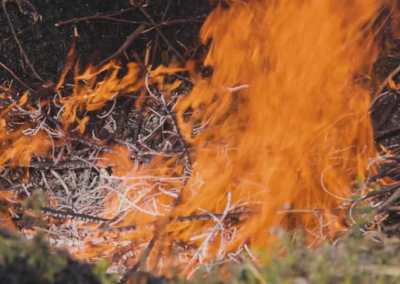On behalf of Mære agricultural school, NIBIO has prepared a report on which measures may be relevant to implement to reduce emissions of greenhouse gases from the farm operations at Mære agricultural school. The report is part of the project "Nullspällingsgården Mære". Data from the farm operation, via, among other things, the climate calculator, is used to estimate emissions of nitrous oxide (N2O), and methane (CH4) from livestock manure, nitrous oxide from mineral fertiliser-nitrogen (N), and emission intensity in dairy and suckling cow production.
Here you will find the report.
Animal manure
The total emission of nitrous oxide and methane from manure on pasture, from storage and during spreading is estimated at 328 tonnes of CO2-equivalents per year. Almost all fertilizer that is spread on fields and meadows at Mære is strip-spread using hose-spreading equipment. This means that emissions from livestock manure are reduced by 13 tonnes of CO2-equivalents than if the fertilizer was spread by tanker. Most of the livestock manure is stored outside in a large lagoon, while some is stored in a manure pit. Both warehouses lack a roof, and the total effect of a tight roof is estimated at 7 tonnes of CO2-equivalents per year. Treatment of livestock manure in biogas plants reduces emissions of ammonia, nitrous oxide and methane. On Mære, the effect of treating all wet manure in biogas plants is estimated at 82 tonnes of CO2-equivalents per year. This corresponds to 25% of total emissions from livestock manure, and is the single measure that produces the greatest effect
Other measures that can have a positive effect are spreading livestock manure under favorable conditions, avoiding autumn spreading, spreading livestock manure over the entire area, and using smaller amounts on organic soil than on soil with a low content of organic material.
Carbon balance
Meadow in long-term rotation, preferably with ice seeding without ploughing, minimizes the transformation of organic material in the soil and reduces the emission of greenhouse gases. On grain areas, the use of catch crops can be sown together with grain to reduce runoff and bind CO2. On the area currently used for grain, the use of catch crops can reduce emissions by 11 tonnes of CO2– equivalents per year.
Milk production
Emissions from milk production are estimated at 0.89 kg CO2-equivalents per kg of fat- and protein-corrected milk. This figure is below the average for Norwegian herds. Higher performance, better roughage quality, and the use of additives in the feed which are under development to reduce methane production in the rumen, can at best result in a further emission reduction of up to 46 tonnes of CO2-equivalents per year.

Dairy cow production
Emissions from suckler cow production at Mære agricultural school are calculated at 23 kg of CO2-equivalents per kg of slaughter. This emission is low compared to calculations from other Hereford herds. Better roughage quality, higher growth, and the use of additives in the feed can also reduce emissions here, which are estimated at up to 11 tonnes of CO2-equivalents per year.
Other agronomic conditions
The following factors are pointed out here that can provide better growing conditions:
- Low pH on some switches - this can increase nitrous oxide emissions
- Good drainage is important going forward
- Little soil compaction gives better soil structure
- Fertilization under favorable weather conditions
- Increased use of pasture and reduced protein feeding




